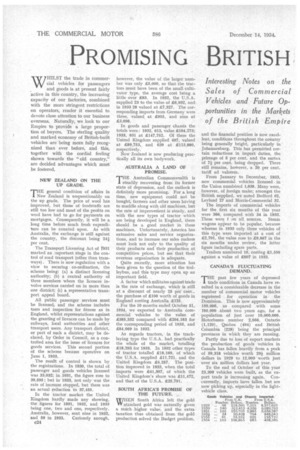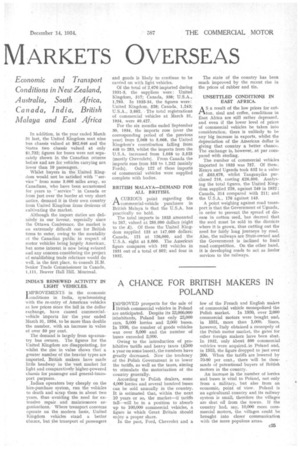PROMISING BRITISH MARKETS OVERSEAS
Page 78

Page 79

If you've noticed an error in this article please click here to report it so we can fix it.
WHTLST the trade in commercial vehicles for passengers and goods is at present fairly active in this country, the increasing capacity of our factories, combined with the more stringent restrictions on operators, render it essential to devote close attention to our business overseas. Naturally, we look to our Empire to provide a large proportion of buyers. The sterling quality and marked economy of British-built vehicles are being more fully recognized than ever before, and this, together with the cordial feeling shown towards the "old country," are decided advantages which must be fostered.
NEW ZEALAND ON THE UP GRADE.
THE general condition of affairs in New Zealand is unquestionably on the up grade. The price of wool has improved, but those of foodstuffs are still too low and most of the profits on wool have had to go for payments on mortgages. Consequently, it will be a long time before much fresh expenditure can be counted upon. As with Australia, the exchange is still against the country, the discount being 24f per cent.
The Transport Licensing Act of f 931 marked an ;mportant stage in the control of road transport (other than tramways). There is now regulation with a view to securing • co-ordination, the scheme being: (a) a distinct licensing authority; (b) a central authority of three members where the licences involve services carried on in more than one district; (c) a representative transport appeal board.
All public passenger services must be licensed, and the scheme includes tests and inspection for fitness as in England, whilst representations against the granting of licences can be made by railways, local authorities and other transport users. Any transport district, or part of such a district, may be declared, by Order in Council, as a controlled area for the issue of licences for goods services. This second portion of the scheme became operative on June 1, 1933.
The result of control is shown by the registrations. In 1930, the total of passenger and goods vehicles licensed was 33,032; in 1931, the figure rose to 39,593; but in 1933, not only was the rate of increase stopped, but there was an actual reduction to 37,455.
In the tractor market the United Kingdom hardly made any showing, the figures for 1931, 1932, and 1933 being one, two and one, respectively. Australia, however, sent nine in 1932; and 59 in 1933. Curiously enough, c24
however, the value of the larger number was only £5,000, so that the tractors must have been of the small cultivator type, the average cost being a little over £83. In 1932, the U.S.A. supplied 23 to the value of £6,932, and in 1933 28 valued at £7,327. The corresponding imports from Germany were three, valued. at £955, and nine at 23,098.
In goods and passenger chassis the totals were: 1932, 613, value £104,273; 1933, 931 at £147,752. Of these the United Kingdom supplied 497, valued at £89,753, and 639 at £113,880, respectively.
New Zealand is now producing practically all its own bodywork.
AUSTRALIA A LAND OF PROMISE.
THE Australian Commonwealth is steadily recovering from its former state of depression, and the outlook is definitely more promising. For a long time, new equipment could not be bought, farmers and other users having to muddle along with old machines, but the rate of improvencent is steady, and with the new types of tractor which are being developed in England, there should be a good market in these machines. Unfortunately, America has extensive sales and service organizations, and to increase our sales makers must look not only to the quality of their products and their production at competitive prices, but see that their overseas organization is adequate.
Quite recently, more attention has been given to the question of the trolleybus, and this type may open up an important field.
A factor which militates against trade is the rate of exchange, which is still at a discount of nearly 25 per cent., the purchase of £100 worth of goods in England costing Australia £125.
For the 10 months ended October 31, 1934, we exported to Australia commercial vehicles to the value of £385,332 compared with £204,183 for the corresponding period of 1933, and £84,069 in 1932.
As regards tractors,in the tracklaying type the U.S.A. had practically the whole of the market, totalling £18,293 for 1933. In 1932 other types of tractor totalled £18,169, of which the U.S.A. supplied £11,721, and the United Kingdom 24,257. The position improved in 1933, when the total imports were £41,307, of which the United Kingdom's share was £11,472, and that of the U.S.A. £25,791.
SOUTH AFRICA'S PROMISE OF THE FUTURE. . WHEN South Africa left the gold VV standard gold was naturally given a much higher value, •and the extra taxation thus obtained from the gold production solved the Budget problem, and the financial position is now excellent, conditions throughout the country being generally bright, particularly in Johannesburg. This has permitted certain reductions in import duties, the primage of 5 per cent, and the surtax of 7f per cent, being dropped. There still remains, however, a 20 per cent. tariff ad valorem.
From January to December, 1933, new commercial vehicles licensed in the Union numbered 1,938. Many were, however, of foreign make; amongst the British supplied, we noted Bedford 62, Leyland 27 and Morris-Commercial 32.
The imports of commercial vehicles for the first six months of this year were 366, compared with 34 in 1933.
These were f all sources. Steam wagons appear to be popular, because whereas in 1933 only three vehicles of this type were imported at a cost of £2,701, the value rose to £9,867 in the six months under review, the latter figure including spare parts.
Trailers numbered 10, costing £1,550 against a value of £807 in 1933.
CANADA'S FLUCTUATING DEMAND.
T"past few years of depressed trade conditions in Canada have resuited in a considerable decrease in the number of commercial motor vehicles registered for operation in the Dominion. This is now approximately 150,000, as compared with some 165,000 about two years ago, for a population of just over 10,000,000. Motorbuses number 2,056, Ontario (1,120), Quebec (494) and British Columbia (228) being the principal provinces in which they are running.
Partly due to loss of export markets the production of goods vehicles in Canada has fallen heavily from a peak of 59,318 vehicles worth 29 million dollars in 1929 to 12,003 worth just over six million dollars last year.
To the end of October of this year 23,309 vehicles were built, as the export trade is increasing again. Concurrently, imports have fallen but are now picking up, especially in the lightvehicle class.
Goods Vehicles and Chassis Imported.
FTWIL U.K. From U.S.A.
Number. Dollars. Number. Dollars. 1929 ... 98 218,300 7,319 8,577,629 1930 ... 140 512,413 4,936 6,089,769 1931. ... 102 255,703 2,883 3,656,587 1935 34 90,428 764848,542 1933 41 53,522 225 193,722
1934 ... 162 106,863 685 458,586
In addition, in the year ended March 31 last, the United Kingdom sent nine bus chassis veined at $62,646 and the States two chassis valued at only $1,732; figures for buses were not separately shown in the Canadian returns before and are for vehicles carrying not fewer than 10 passengers.
Whilst buyers in the United Kingdom would not be satisfied with " service" from some 3,000 miles away, so Canadians, who have been accustomed for years to "service in Canada or from just over the border at very short notice, demand it in their own country from United Kingdom firms desirous of • cultivating the market.
Although the import duties are definitely in our favour, especially since the Ottawa Conference, the market is an extremely difficult one for British firms to enter, owing to the mentality of the Canadian public in respect of motor vehicles being largely American, but some interest is now being evinced and any concern considering the project of establishing trade relations would do well, in the first place, to consult H.M. Senior Trade Commissioner in Canada, 1,111, Beaver Hall Hill, Montreal.
INDIA'S RENEWED ACTIVITY IN LIGHT VEHICLES.
IMPROVEMENTS in the economic lconditions in India, synchronizing with the re-entry of American vehicles at low prices since the fall in the dollar exchange, have caused commercialvehicle imports for the year ended March 31, 1934, to be more than double the number, with an increase in value of over 50 per cent.
The demand is largely from up-country bus owners. The figures for the United Kingdom are disappointing, for whilst the rise in value shows that a greater number of the heavier types are imported, British makers have made little headway in the vast market for light and comparatively higher-powered chassis for passenger and general-transport purposes.
.Indian operators buy cheaply on the hire-purchase system, run the vehicles to death and scrap them in about two years, thus -avoiding the need for extensive repair and maintenance organizations. Where transport concerns operate on the modern basis, United Kingdom vehicles stand a better chance, but the transport of passengers and goods is likely to continue to be carried on with light vehicles.
Of the total of 2,676 impbrted during 1931-3, the suppliers were: United Kingdom, 517; Canada, 338; U.S.A., 1,793. In 1933-34, the figures were: United Kingdom, 528; Canada, 1,243; U.S.A., 3,692. The total registrations of commercial vehicles at March 31, 1934, were 40,427.
For the six months ended September 30, 1934, the imports rose (over the corresponding period of the previous year) from 2,068 to 5,068, the United Kingdom-'s contribution falling from 448 to 283, whilst the imports from the U.S.A. increased from 1,058 to 3,525 (mostly Chevrolets). From Canada the imports rose from 555 to 1,242 (mainly
Fords). Only 122 of these imports of commercial vehicles were supplied complete with bodies.
BRITISH MALAYA—DEMAND FOR ALL BRITISH.
• A CURIOUS point regarding the . commercial-vehicle purchases in British Malaya is that the U.S.A. has practically no hold.
The total imports in 1933 amounted to 267, valued at 285,000 dollars (eight to the £). Of these the United Kingdom supplied 133 at 147,000 dollars; Canada, 121 at 126,000, and the U.S.A. eight at 5,000. The American. figure compares with 102 vehicles in 1931 out of a total of 502; and four in 1932.
The slate of the country has been much improved by the recent rise in the prices of rubber and tin.
UNSETTLED CONDITIONS IN EAST AFRICA.
As a result of the low prices for cotton, sisal and coffee, conditions in East Africa are still rather depressed, and even if the lower level of prices of commercial vehicles be taken into consideration, there is unlikely to be any big increase in exports, whilst the depreciation of the American dollar is giving that country a better chance. The exchange is, however, at par compared with sterling.
The number of commercial vehicles imported in 1933 was 757. Of these, Kenya and Uganda took 532 to a value of £63,678, whilst Tanganyika purchased 216, costing £26,000. Analysing the total figures, the United Kingdom supplied 229, against 249 in 1932 Canada, 314 compared With 211; and the U.S.A., 176 against 143.
A point weighing against road transport is that the Government of Uganda, in order to prevent the spread of disease in cotton seed, has decreed that the seed must be sold in the districts where it is grown, thus cutting out the need for fairly long journeys by road. Also, the railways are State-owned and the Government is inclined to limit road competition. On the other hand, it is developing roads to act as feeder services to the railways.




































































































































































